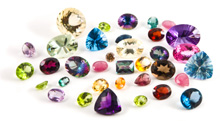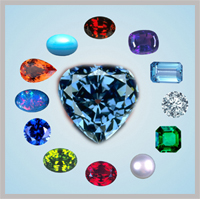Value of gemstones

There is no universally accepted grading system for gemstones. Diamonds are graded using a system developed by the Gemological Institute of America (GIA) in the early 1950s. Historically, all gemstones were graded using the naked eye. The GIA system included a major innovation: the introduction of 10x magnification as the standard for grading clarity. Other gemstones are still graded using the naked eye .
A mnemonic device, the "four Cs" (colour, cut, clarity and carats), has been introduced to help the consumer understand the factors used to grade a diamond. With modification, these categories can be useful in understanding the grading of all gemstones. The four criteria carry different weight depending upon whether they are applied to colour gemstones or to colourless diamond. In diamonds, cut is the primary determinant of value, followed by clarity and colour. Diamonds are meant to sparkle, to break down light into its constituent rainbow colours (dispersion), chop it up into bright little pieces (scintillation), and deliver it to the eye (brilliance). In its rough crystalline form, a diamond will do none of these things; it requires proper fashioning and this is called "cut". In gemstones that have colour, including colour diamonds, it is the purity and beauty of that colour that is the primary determinant of quality.
Physical characteristics that make a colour stone valuable are colour, clarity to a lesser extent (emeralds will always have a number of inclusions), cut, unusual optical phenomena within the stone such as colour zoning, and asteria (star effects). The Greeks, for example, greatly valued asteria in gemstones, which were regarded as a powerful love charm, and Helen of Troy was known to have worn star-corundum.
Historically, gemstones were classified into precious stones and semi-precious stones. Because such a definition can change over time and vary with culture, it has always been a difficult matter to determine what constitutes precious stones.
Aside from the diamond, the ruby, sapphire, emerald, pearl (strictly speaking not a gemstone) and opal have also been considered to be precious. Up to the discoveries of bulk amethyst in Brazil in the 19th century, amethyst was considered a precious stone as well, going back to ancient Greece. Even in the last century certain stones such as aquamarine, peridot and cat's eye have been popular and hence been regarded as precious.
Nowadays such a distinction is no longer made by the trade. Many gemstones are used in even the most expensive jewelry, depending on the brand name of the designer, fashion trends, market supply, treatments etc. Nevertheless, diamonds, rubies, sapphires and emeralds still have a reputation that exceeds those of other gemstones.
Rare or unusual gemstones, generally meant to include those gemstones which occur so infrequently in gem quality that they are scarcely known except to connoisseurs, include andalusite, axinite, cassiterite, clinohumite and red beryl.
Gem prices can fluctuate heavily (such as those of tanzanite over the years) or can be quite stable (such as those of diamonds). In general per carat prices of larger stones are higher than those of smaller stones, but popularity of certain sizes of stone can affect prices.


















